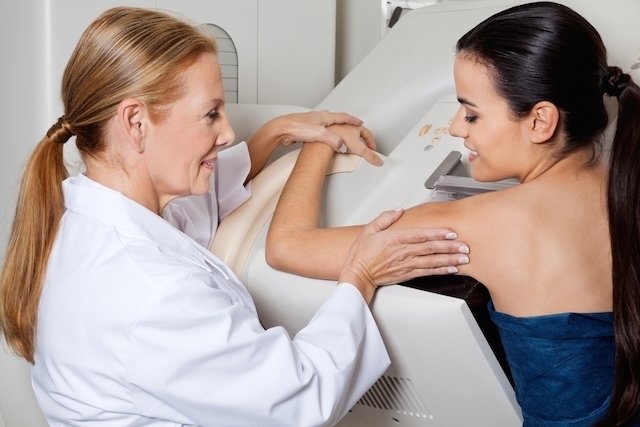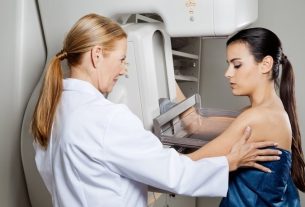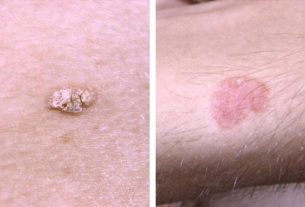Breast calcification is the accumulation of small calcium particles in the breast tissue. This can happen due to natural aging, but it can also be a consequence of breast implants, breast infection, or a sign of cancer.
Breast calcifications normally do not generate symptoms, being identified in routine exams such as mammography, and are classified as benign or suspected malignancy according to their characteristics, such as size and shape. See the main tests that detect breast cancer.
In case of calcifications in the breast, especially if the calcifications are suspected of malignancy, it is recommended to consult a mastologist. Treatment depends on the characteristics of the calcifications and may involve their removal with surgery, medication and/or radiotherapy.

Symptoms of breast calcification
Calcification in the breast does not normally cause any symptoms and may not even be palpated during breast self-examination. For this reason, calcification is almost always identified on routine imaging tests, such as mammography.
If symptoms such as itching in the breast, release of fluid or change in the color and shape of the nipple are noticed, a gynecologist should be consulted, as they may indicate the existence of other problems, including cancer. Know the main symptoms of breast cancer.
Possible causes
One of the main causes of breast calcification is natural aging, in which breast cells undergo a gradual degenerative process.
Other possible causes for the appearance of calcifications in the breast are:
- Remains of breast milk;
- Breast infection;
- Breast injuries;
- Stitches or silicone implantation in the breasts;
- Fibroadenoma.
Although it is most often a benign process, calcium deposits in breast tissue can be a sign of breast cancer and should be investigated and treated by a doctor if necessary.
How to confirm the diagnosis
The diagnosis of breast calcifications is normally made by a mastologist or gynecologist based on the results of tests, such as mammography and breast ultrasound.
If you want to make an appointment, you can find the breast specialist closest to you using the tool below:
Taking care of your health has never been easier!
According to the results of the biopsy and the tests indicated by the doctor, it is possible to check the severity of the calcification and establish the best treatment.
Types of calcification
According to the characteristics observed on mammography or breast ultrasound, calcifications can be classified into:
- Benign calcificationwhich is characterized by macrocalcifications with a regular shape and well-defined borders;
- Probably benign calcificationin which macrocalcifications have an amorphous appearance;
- Calcification suspected of malignancyin which grouped microcalcifications can be observed;
- Calcification highly suspicious of malignancywhich is characterized by the presence of microcalcifications of varying sizes, high density and with ramifications.
The classification of the types of calcification is essential for the doctor to indicate the most appropriate treatment, especially in cases of suspected malignancy.
How the treatment is carried out
Treatment for breast calcification depends on the characteristics of the calcifications. Normally, in cases of calcification with benign characteristics, only monitoring is carried out, and it is recommended that the woman undergo a mammogram at least once a year or according to the advice of the mastologist.
In cases where the calcifications have a more irregular shape or asymmetry, a biopsy of the calcification is recommended to check whether it is likely to be a sign of the presence of a nodule or tumor. Furthermore, if ramifications in the calcification are noted during the imaging examination, a biopsy is recommended and, if malignancy is found, surgery to remove the calcification, which can be complemented by radiotherapy and/or the use of medications, in some cases.
Can calcification turn into cancer?
Calcification cannot become cancer, as it corresponds to the deposition of calcium in the breast tissue and not due to the abnormal proliferation of cells. However, the presence of calcification can be a sign of cancer, especially when several irregularly shaped, asymmetrical and branching points of calcification are noticed on a mammogram or breast ultrasound.
Bibliography
- RADIOPAEDIA. Breast calcifications. Available at: <https://radiopaedia.org/articles/breast-calcifications>. Accessed on June 28, 2023
- SPAK, DA et al. BI-RADS® fifth edition: A summary of changes. Diagnostic and Interventional Imaging. Vol.98, n.3. 179-190, 2017
- BREAST CANCER NOW. Breast calcifications. Disponível em: <https://breastcancernow.org/information-support/have-i-got-breast-cancer/benign-breast-conditions/breast-calcifications>. Acesso em 01 out 2021
- BRAZILIAN COLLEGE OF RADIOLOGY. Appropriate methodology in the imaging diagnosis of breast microcalcifications. 2017. Disponível em: <https://cbr.org.br/wp-content/uploads/2017/06/05_02v2.pdf>. Acesso em 01 out 2021

Sign up for our newsletter and stay up to date with exclusive news
that can transform your routine!
Warning: Undefined array key "title" in /home/storelat/public_html/wp-content/plugins/link-whisper-premium/templates/frontend/related-posts.php on line 12
Warning: Undefined array key "title_tag" in /home/storelat/public_html/wp-content/plugins/link-whisper-premium/templates/frontend/related-posts.php on line 13



